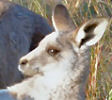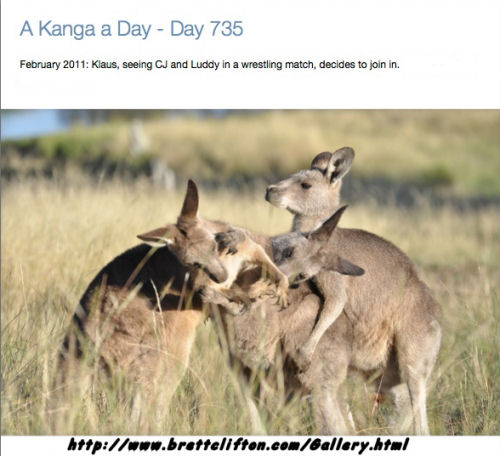Kangaroos: Competition and Efficiency Commission - kindness no priority - Submissions needed
 PLEASE make a brief Submission urgently. Under the heading of Competition and Efficiency, economists easily dispense with democratic objections and humane values. Only the strictly illegal is out, and authorities are always willing to change the law if money is involved. The campaign to slaughter kangaroos for their meat in Victoria has been building over the years, despite its unsustainability and the distress it produces in kangaroos and the many people who love this species. The Department of Sustainability has shown itself to utterly lack science or responsibility in monitoring and protecting our native wildlife. More often than not it awards permits to kill kangaroos without checking their justifications. The Auditor General's report in 2009 showed that the Victorian government did not know what it was doing with regard to wildlife. It would therefore be a serious error to change laws to reward kangaroo killing and to make it easier.
PLEASE make a brief Submission urgently. Under the heading of Competition and Efficiency, economists easily dispense with democratic objections and humane values. Only the strictly illegal is out, and authorities are always willing to change the law if money is involved. The campaign to slaughter kangaroos for their meat in Victoria has been building over the years, despite its unsustainability and the distress it produces in kangaroos and the many people who love this species. The Department of Sustainability has shown itself to utterly lack science or responsibility in monitoring and protecting our native wildlife. More often than not it awards permits to kill kangaroos without checking their justifications. The Auditor General's report in 2009 showed that the Victorian government did not know what it was doing with regard to wildlife. It would therefore be a serious error to change laws to reward kangaroo killing and to make it easier.

Submissions on VCEC draft report and lifting the processing ban on commercially utilising kangaroos
. The Victorian Competition and Efficiency Commission (VCEC) has released a new draft report calling for lifting the processing ban on commercially utilising kangaroos in Vic, and for a more simplified ATCW permit system, which at its best is already simple and badly under resourced. (A pdf of the Report may be accessed here.)
· Kangaroos are not commercially harvested in Victoria, Northern Territory or the ACT. According to Autsralian government data kangaroo numbers have dramatically declined by 55% since 2001 in commercial shooting zones across Australia, the recent floods have added another heavy toll on kangaroos in those areas.
· There is no data or figures of kangaroo populations in Victoria, the DSE state in their fact sheet that a commercial industry is not viable as set up costs would outweigh profit, public opposition, and low kangaroo numbers.
· Currently a landowner does not have to pay any fee for an ATCW permit to be issued to them; the VCEC report states that it costs approximately $480 per permit application.
· Under the current system it costs Victorian tax payers for landowners to kill protected kangaroos without their say or consent, why then is this cost not passed onto the landowner if they are supposedly benefitting from it?
· This is particularly pertinent to wildlife carers who along with their animals already suffer from ATCW permits given to adjoining landowners placing at risk the very kangaroos they have a license to hand rear.
· The real waste is that kangaroos are killed in the first place, not that they are left to rot.
Please help oppose the commercial processing of kangaroos in Victoria by emailing a submission/letter to the VCEC
Call to lift kangaroo processing ban
Regarding the VCEC draft report in relation to lifting the processing ban on commercially utilising kangaroos in Vic, those seeking more information should read from the Introduction p.57 (1). The section on Authorities to Control Wildlife (ATCWs) is on p.104 (48) but it has been pasted at the end of this article for easy reference.
Wildlife carers are already disadvantaged from ATCW permits given to adjoining landowners placing at risk the very kangaroos they have a license to hand rear.
Currently a landowner does not have to pay a fee for an ATCW permit to be issued to them, the report states that it costs approximately $480 per permit application, along with this it’s argued that the system should be simplified!! As we all well know it already is pretty 'simple'. (funny - it costs to get an FOI (Freedom of Information)!
Your taxes
Under the current system it costs Victorian tax payers for landowners to kill protected kangaroos without their say or consent, why then is this cost not passed onto the landowner if they are supposedly benefiting from it?
If those who seek permits to kill kangaroos had to pay for a permit they might think before applying for one and properties would be inspected to ensure valid reasons are given for issuing them.
Most perpetrators of abuse using ATCW permits are hobby farmers. It would be more appropriate for ATCW to be issued only to landowners whose sole income is from the land/farming.
There is a huge need to educate and to create awareness of how essential it is to protect biodiversity. Make ATCW permits harder to get with tough requirements.
Email your submissions to
[email protected]
Cc [email protected]
Extract from Draft Report: Part 2 – Priorities for Regulatory Reform
An Inquiry into Victoria’s regulatory framework
A draft report for further consultation and input
March 2011
3.2.5 Authority to Control Wildlife
In Victoria, control of wildlife is regulated under the Wildlife Act 1975 (Vic). In particular, lethal control measures are heavily restricted, requiring approval from DSE through an Authority to Control Wildlife (ATCW). DSE states that an ATCW for lethal control measures is issued only as a last resort where other non-lethal options are impractical (DSE 2008b, p. 1).
The Victorian Farmers Federation (VFF) (sub. 17, p. 5) identifies ATCWs as a source of excess burden for its members. The submission points to several issues, including:
prohibition on commercial use of kangaroo carcasses
the cost and complexity of obtaining permits.
The VFF also identifies health and safety issues arising from an alleged restriction on removing a culled kangaroo carcass from the point at which the animal dies. The Commission understands that DSE’s guidance materials do, in fact, indicate that the carcasses of animals destroyed under an ATCW can be removed (DSE 2008b, p. 1).
Complexity and delays in the permit application process
Obtaining an ATCW requires the applicant to go through a relatively in-depth approvals process and submit an application form detailing the proposed controlmeasures, and details of other non-lethal control measures already attempted. In many cases a site visit from DSE field officers is a prerequisite to approval.
The rationale for extensive assessment of applications is to ensure that pest kangaroos are only destroyed as a last resort. In 2008, 1592 ATCWs were issued for three species of kangaroo. If wallabies are included, the total increases by 1798. Long term data suggest around 30 000 kangaroos are destroyed under ATCWs each year in Victoria (DSE 2010a).
No data are publicly available on the average cost of individual permits. However, information available to the Commission suggests an industry cost of just under $1 million.1
In its submission, the VFF recommends that kangaroos be ‘declared unprotected’ on private land (sub. 17, p. 5). The Commission does not believe that this would be possible without jeopardising policy outcomes. However, it should be possible to reduce the costs to landholders of obtaining ATCWs without compromising protection of wildlife. In particular, DSE could consider simplifying the application process, as there may be room to:
simplify the application form, consolidating the application and landholder self-assessment to eliminate duplicate requests for information
reduce the need for on-site assessments by field staff.
Prohibition on commercial use of culled kangaroos
The Victorian Government, while allowing lethal control measures for kangaroos and other wildlife (in limited circumstances, as noted above), prohibits commercial use of culled kangaroos (DSE 2010a). ‘Commercial use’ would primarily entail sale of the carcass for processing to meat and leather products (Environment and Natural Resources Committee 2000, p. 93).
This ban is linked to the Government’s overall opposition to establishing a kangaroo meat industry in Victoria, based on a stated low kangaroo population density, and community opposition to commercial kangaroo hunting (Environment and Natural Resources Committee 2000, p. 378). The underlying concern is that introducing additional incentives to destroy ‘pest’ kangaroos could lead to de facto commercial exploitation of the wild population.
The tight controls on ATCWs and the high level of monitoring by DSE suggest that the Government should be able to detect and prevent culls proposed
1 Taking into account the need for a site visit and the rigour of the permit system, a reasonable starting point would be one day per permit. Using default wage, overhead and on-cost assumptions from the Department of Treasury and Finance’s guidance on estimating administrative burdens, this yields an administrative cost associated with each application of approximately $480, or $863 000 across industry. There may be further costs from ongoing damage from pest animals where control action is delayed by administrative processes primarily for the commercial value of kangaroos. Assuming no change in the rate at which ATCWs are granted, permitting the sale of carcasses would pose no further threat to the population, with those animals culled under permit, by definition, being within sustainable limits.
While — as noted by the VFF — it is not clear whether the numbers of kangaroos culled in Victoria would make a kangaroo products industry economic (sub. 17, p. 5), a ban appears unnecessarily burdensome and redundant in light of other measures to protect biodiversity and animal welfare. The Government should consider lifting this ban. If this option is taken, impacts should be monitored closely and, in no later than 3 years, the operation of the scheme should be reviewed to assess whether removal of the ban has harmed welfare or biodiversity outcomes. Draft recommendation 3.5
That the Government change aspects of the control of pest wildlife under Authorities to Control Wildlife (ATCW) to:
simplify the process for obtaining an ATCW
allow commercial use of kangaroos and wallabiesdestroyed under an ATCW, where such use does not compromise other policy objectives.

Recent comments